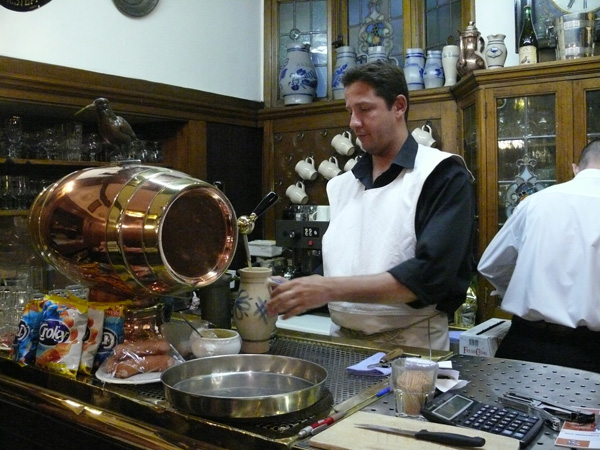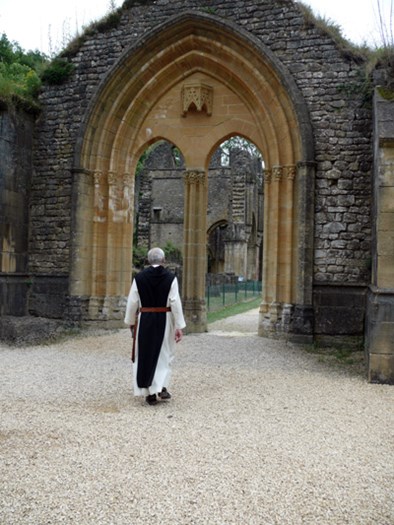BRUSSELS, BELGIUM – It was while exploring the labyrinth of narrow streets that run off this city’s handsome main square, the Grand Place, that I was lured down an alley by the sight of two men sitting at a table sipping beer.
As I started down the narrow impasse, whose walls were streaked with sunlight, little did I realize that this was just the start of an incredible journey that would eventually lead me to discover the “real” Belgium – a country of quaint villages and dynamic cities, imaginative cuisine, lots of historic wonders, and, best of all, the best beer on the planet.
An open wooden door at the end of the impasse invited me to enter Le Taverne Cirio, a small pub – circa 1886 - where a local man insisted I try “one of my country’s famous beers.”
I had plenty to choose from – Belgium is the beer capital of the world, and home to the world’s largest brewer, Inbev-Interbrew, along with 120 others who produce hundreds of varieties served up at Belgium’s more than 22,000 taverns.
Pils, the country’s most popular brew, is what the man named Sacha recommends.
“It’s a great introduction for a stranger like yourself but we will also try some of our hardier varieties as well,” promises the man, who tells me back in medieval times there were 3,300 Belgium brewers.
“And before World War I, there was one pub for every 35 Belgians,” says Sacha, who claims that this tiny country of 10 million sandwiched between the Netherlands, France, Luxembourg and Germany, consumes - “per capita” - more beer annually than even the English.
And the Belgians take their beer seriously.


Left: Beer is what made Belgium famous and there's lots to choose from. Right: Trappist abbeys also make beer.
“Patients are given beer in their hospital beds. It’s very good for the stomach and kidneys you know?” says Sacha. “And there are many museums and national festivals (at least six) devoted to beer.”
Over a glass of legendary lambic – a hearty brew that traces its roots back to the middle ages – Sacha says the best of Belgium’s beers are actually produced by Trappist monks at abbeys scattered throughout the country.
“There are only seven Trappist monasteries in the world and six of them are in Belgium (the other is in neighbouring Holland),” boasts Sacha as the charming Le Cirio begins to fill up with mid-day drinkers.
Le Cirio is just one of many old taverns one finds in Brussels’ Lower Town, the historic district of this EU capital that is one of the most beautiful, albeit underrated cities in Europe.
And the old pubs are very attractive – many feature wooden beam ceilings, mahogany walls, and some even have stain glass windows, thus making them look more like little chapels, with their bars serving as alters. Le Cirio, Au Bon Vieux Temps and La Becasse are now my favourite places to drink in Brussels; maybe the world.
As we finish a glass of cheery flavoured Lambic, Sacha suggests I hire a car and tour the regions where the small Trappist breweries are located – the furthest is only about a two hour drive from Brussels, near the border with France.
The charming towns and villages and idyllic rolling farmland one sees along the way makes the drive well worth the effort. And the super highways of Belgium, known as autoroutes, and the back roads are all well marked with international symbols so the driving is effortless.
So, on Sacha’s recommendation, I and some friends jump in a mini-van the next morning and head out along Belgium’s beer trail in the direction of Orval, where the first of the three Trappist abbeys we have targeted for inspection is located.
Before reaching Orval, though, we make a pit stop in Bastogne, the World War II city where legendary American General George Patton and his 80,000 troops broke the back of the much stronger Nazi Army (200,000 strong) during one of the fiercest battles of the war and pushed them back into Germany.
Much of lovely Bastogne was destroyed during the four-week Battle of the Bulge – 200 buildings were leveled - but the town has long since been returned to its former charm, featuring outdoor cafes, lovely shopping streets and several handsome squares. One of the squares is named in honour of Patton and another for American General Anthony McAuliffe, the besieged commander of Bastogne whom Patton had to rescue. When told to surrender by the surrounding Germans, McAuliffe simply replied, “nuts” and held out until Patton arrived to save the day.
The World War II museum just outside the city – it was erected on the actual battle field - is one of the most moving we’ve ever seen and it’s about to get much bigger since Bastogne’s museum was recently chosen to hold all artifacts pertaining to Belgium’s involvement in World War II.
One of the most fascinating details a local man named Jean Claude Lemaire tells us about Bastogne is that its main street actually has two names – one side is known as Rue du Sablon while the other is Rue du Vivier.
“We Belgians like to confuse visitors,” Jean Claude tells us.
By the time we reach nearby Florenville, we’ve worked up an appetite and can’t resist the sweet smells coming from Les Chocolats d’Edouard leschocolatsdedouchard.be on Place Albert, the town’s main street.
We’re greeted by amiable Chef Edouard, who suggests we have a “special” lunch of “steak with a sauce infused with red wine and dark chocolate,” says Chef as he disappears into his stainless steel kitchen to prepare our meal.
The server tells us Chef recently returned from Italy where he learned how to combine chocolate with different foods and opened this restaurant so more tourists would have the town where he grew up.
Since opening, the weekend traffic at Les Chocolats d’Edouard, especially from nearby France, has been brisk and once we taste the meal – presented with the artistic flare of a Michelin star Chef – we understand why Edouard’s restaurant has become the talk of the town. Chef also offers three-day cooking courses and we all wanted to sign up.
Soon after lunch we arrive at the Abbaye d’ Orval, which traces its roots back to 1070 but was destroyed during the French Revolution? It reemerged in its present magnificent state in 1926.
Father Francois is there to greet us. He is one of 15 monks – down from the original 150 the new monastery was built to accommodate – and he tells us the monks determine the quantity of beer –24,000 bottles a day –produced but that the actual production is done by locals in a brewery constructed just outside the walls of the abbey.
The Orval brew, made with sacred water from the abbey’s Mathilda Spring , is delightful - a bit sweet and very hearty – but it’s the abbey’s old ruins, massive church, amazing museum and especially Father Francois that we really find intoxicating during our visit.
An overnight stay in charming Bouillon at the rustic Hotel Pommeraie, which comes with squeaky floors and all the charm of a small French chateau; and an excellent meal made with local ingredients like wild boar in the Hotel Cosy’s Cosy Restaurant, works up our appetite for more touring, Belgium style.
By the way, from the restaurant Cosy, which sits perched on a hill overlooking Bouillon, one gets to see all this small town has to offer - a 1,000-year-old medieval castle once owned by Godfrey of Bouillon, who sold it to finance the First Crusade (during which he declared himself King of Jerusalem); the Semois River, which cuts through the town (it’s rapids are cherished by kayakers and canoeists); and the Swiss-style town square surrounded by delightful cafes.
Up bright and early the next morning and greeted by an azure sky, we’re off on Day Two of our journey through Belgium’s beer country with stops at:
Maredsous – This is where another of the legendary Trappist breweries is located. Here we enjoy a delightful lunch in the abbey’s public cafeteria – the cheese made by the monks and used in sandwiches is delicious and the restaurant is so inexpensive that locals use it on a regular basis. The monastery grounds and buildings are a delight to tour - we’re even afforded a look inside the rooms where the abbey’s 35 monks live and pray. The abbey is also home to one of Belgium’s elite schools, where the country’s aristocracy sends their kids. The beer made here is our favourite on the trip and it s even exported to places like Canada.
Spa – This is regarded as the spa capital of the world – thanks to its name - and it is where we spend the night at the best Best Western Hotel we’ve ever experienced – the Villa des Fleurs, which is housed in one of the old villas built by the rich and famous of Belgium and France in the late 1800s. The aristocracy liked vacationing here to experience the healing and soothing powers of the local hot springs first discovered by the Romans and the town is still popular today thanks to its world-class public spa and bathing facility, casino, great restaurants and old world charm.
Moulin – This is where the Val-Dieu Abbey produces a white brew that is one of the most popular in all Belgium. The abbey escaped the French Revolution but the monk population died out in 2001. Production of the famed beer was taken over in 1997 by local craftsmen but the abbey, where an excellent cheese is produced, remains a favourite with tourists.
Dinant – About an hour outside Brussels on our return to the Belgium capital, we take a side road off the main highway and stumble upon this gem of a city whose history dates back to Neolithic, Celtic and Roman times. The handsome citadel that guards the city from high atop its mountain perch and the brilliance of Notre Dame cathedral’s bulbous spire and rich interior, has us wishing we had more time to explore this city that was almost totally destroyed during World War II. The shores of the River Meuse are now lined with quaint cafes and the city has become famous for its ginger bread creations. It is indeed a sweet treat.
Back in Brussels, we return to Le Taverne Cirio in hopes of finding Sacha to thank him for helping us find the “real” Belgium.
Sacha is nowhere in sight so our small group toasts a country that showed us it is far more than just Brussels, Bruge and beer.
Cheers, Belgium!